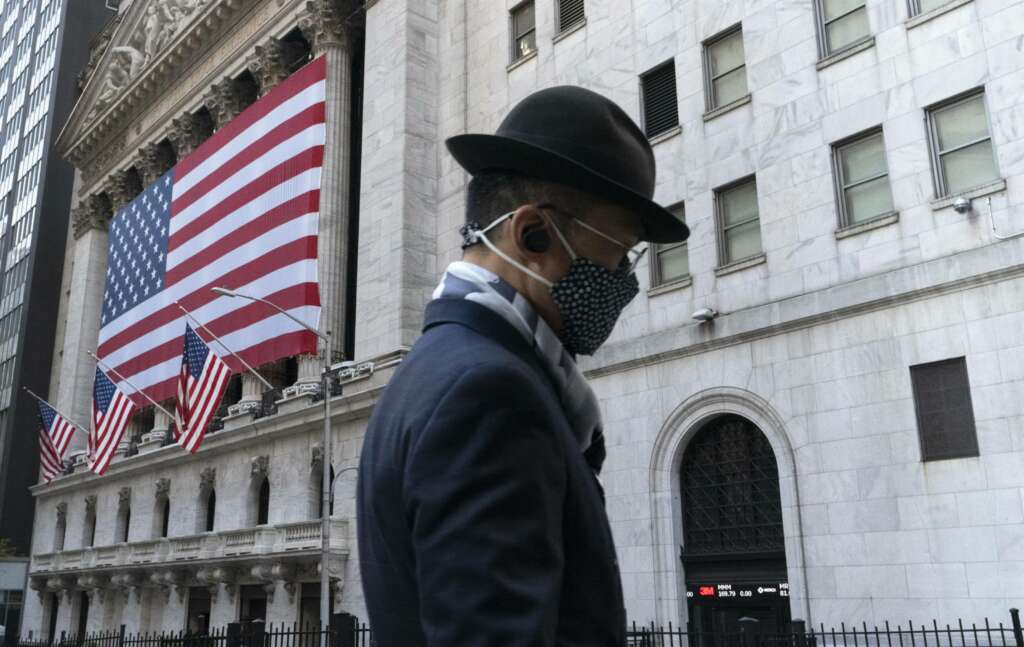
A late-day rebound in technology companies pulled the stock market out of a slump and helped give the S&P 500 its first weekly gain in three weeks. The index rose 2% Friday. Investors were encouraged by a government report that U.S. employers picked up the pace of hiring last month. However they were also still anxious over a recent surge in long-term interest rates in the bond market, which can slow the economy and discourage borrowing. The yield on the 10-year Treasury note pulled back from a midday spike and wound up at 1.56%, only slightly higher than a day earlier.
THIS IS A BREAKING NEWS UPDATE. AP’s earlier story follows below.
Stocks shook off an early slide and turned solidly higher in afternoon trading Friday, placing the market on track to snap a three-day losing streak.
The S&P 500 was 1.9% higher as of 3:43 p.m. Eastern time, after spinning more than 360 degrees earlier. The benchmark index had jumped to an an immediate 1% gain at the start of trading, only to drop quickly to a 1% loss, before charging back again.
Other stock indexes went through similar zigzags. The Dow Jones Industrial Average was up 584 points, or 1.9%, at 31,507, after erasing an earlier loss of 157 points. The Nasdaq composite was 1.5% higher after it earlier flipped between a gain of 1.2% and a loss of 2.6%.
The indexes’ gyrations came as investors struggle to figure out what an encouraging report on the economy and the recent march higher for bond yields should mean for the market.
The spark for all the uncertainty was a government report that showed employers added hundreds of thousands more jobs last month than economists expected. That’s an encouraging sign for the economy, and it helped lift Treasury yields, with the closely watched 10-year yield momentarily topping 1.60%.
The yield later fell back, down to 1.55% in afternoon trading, matching what it was yielding late Thursday, though it remains well above its roughly 0.90% level at the end of last year.
Friday’s afternoon resurgence for stocks coincided with the moderation of yields in the bond market.
For about a year, the stock market kept climbing on expectations that an economic recovery was on the way, even when the coronavirus pandemic meant conditions at the time seemed very bleak. Now that the recovery is much closer on the horizon, the market is unsettled because one of the main underpinnings for that incredible run is under threat: ultralow interest rates.
Yields have been marching higher with rising expectations for the economy’s growth and for the inflation that could accompany it. Economists have been upgrading their forecasts for this year as more people get COVID-19 vaccines, businesses reopen and Congress gets closer to pumping another $1.9 trillion of financial aid into the economy.
The worry is that inflation could take off, or something else could happen to jack yields up even further.
It’s the speed at which Treasury yields have climbed that has gotten Wall Street so uncomfortable, more than the actual level, which is still low relative to history.
Higher yields put downward pressure on stocks generally, in part because they can steer away dollars that had been headed for the stock market and into bonds instead. That makes investors less willing to pay as high prices for stocks.
The pressure is most intense on stocks that look the most expensive, relative to their profits, as well as those bid up on expectations of fast growth far into the future. Critics say most stocks across the market look expensive after prices climbed much, much faster than profits, and warnings about a possible bubble have been on the rise.
Tech stocks and other high-growth companies in particular have been at the center of the downdraft. They soared more than the rest of the market for much of the pandemic, and in the years preceding it. On Friday, Tesla was the heaviest weight dragging on the S&P 500.
It’s another reminder of how dominant Big Tech stocks have become in the market. If inflation does ultimately remain under control, as the Federal Reserve’s chair and many economists expect, the general expectation along Wall Street is that most stocks could benefit.
A stronger economy would mean bigger profits for companies, which would allow their prices to hold steady or rise, even if rates are climbing.
By Friday afternoon, the vast majority of stocks in the S&P 500 were rising, with energy producers making some of the largest gains. Diamondback Energy jumped 4.4%, and Chevron gained 4.2% after the price of U.S. crude oil rallied 3.5%.
Tech stocks would likely also see some improvement in their profits, just not to the same degree as companies whose businesses are closely tied to the strength of the economy, such as banks or travel companies.
But Big Tech stocks have grown so big that their movements can mask what’s going on in the broad market. Five Big Tech stocks alone make up more than 21% of the S&P 500 by market value, so weakness for tech can hold back S&P 500 index funds even if many stocks within it are rising.
All the big movements in the bond market have increased attention on the Federal Reserve, whose chair said this week that he’s noticed the recent climb in yields. He disappointed some investors when he didn’t offer anything more forceful that could cap the rise. That has anticipation building for the Fed’s next policy meeting, a two-day session that ends March 17, and whether Powell will offer any more guidance on what moves the Fed may make next.
___
AP Business Writer Elaine Kurtenbach contributed.
Copyright © 2021 . All rights reserved. This website is not intended for users located within the European Economic Area.
